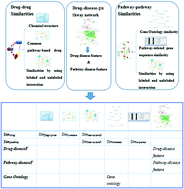当前位置:
X-MOL 学术
›
Mol. Biosyst.
›
论文详情
Our official English website, www.x-mol.net, welcomes your feedback! (Note: you will need to create a separate account there.)
Prediction of drug–pathway interaction pairs with a disease-combined LSA-PU-KNN method
Molecular BioSystems Pub Date : 2017-10-12 00:00:00 , DOI: 10.1039/c7mb00441a Fan-Shu Chen 1, 2, 3, 4, 5 , Hui-Yan Jiang 1, 2, 3, 4, 5 , Zhenran Jiang 1, 2, 3, 4, 5
Molecular BioSystems Pub Date : 2017-10-12 00:00:00 , DOI: 10.1039/c7mb00441a Fan-Shu Chen 1, 2, 3, 4, 5 , Hui-Yan Jiang 1, 2, 3, 4, 5 , Zhenran Jiang 1, 2, 3, 4, 5
Affiliation

|
Prediction of new associations between drugs and targeting pathways can provide valuable clues for drug discovery & development. However, information integration and a class-imbalance problem are important challenges for available prediction methods. This paper proposes a prediction of potential associations between drugs and pathways based on a disease-related LSA-PU-KNN method. Firstly, we built a drug–disease–pathway network and combined the drug–disease and pathway–disease features obtained by different types of feature profiles. Then we applied a latent semantic analysis (LSA) method to perform dimension reduction by combining positive-unlabeled (PU) learning and k nearest neighbors (KNN) method. The experimental results showed that our method can achieve a higher AUC (the area under the ROC curve) and AUPR (the area under the PR curve) than other typical methods. Furthermore, some interesting drug–pathway interaction pairs were identified and validated.
中文翻译:

用疾病结合的LSA-PU-KNN方法预测药物-途径相互作用对
药物与靶向途径之间新关联的预测可以为药物发现和开发提供有价值的线索。但是,信息集成和类别不平衡问题是可用的预测方法的重要挑战。本文提出了一种基于疾病相关LSA-PU-KNN方法的药物与途径之间潜在关联的预测。首先,我们建立了一个药物-疾病-途径网络,并结合了通过不同类型的特征档案获得的药物-疾病和途径-疾病特征。然后,我们将潜在的语义分析(LSA)方法通过结合正无标签(PU)学习和k最近邻(KNN)方法来进行降维。实验结果表明,与其他典型方法相比,我们的方法可以获得更高的AUC(ROC曲线下的面积)和AUPR(PR曲线下的面积)。此外,鉴定并验证了一些有趣的药物-途径相互作用对。
更新日期:2017-11-21
中文翻译:

用疾病结合的LSA-PU-KNN方法预测药物-途径相互作用对
药物与靶向途径之间新关联的预测可以为药物发现和开发提供有价值的线索。但是,信息集成和类别不平衡问题是可用的预测方法的重要挑战。本文提出了一种基于疾病相关LSA-PU-KNN方法的药物与途径之间潜在关联的预测。首先,我们建立了一个药物-疾病-途径网络,并结合了通过不同类型的特征档案获得的药物-疾病和途径-疾病特征。然后,我们将潜在的语义分析(LSA)方法通过结合正无标签(PU)学习和k最近邻(KNN)方法来进行降维。实验结果表明,与其他典型方法相比,我们的方法可以获得更高的AUC(ROC曲线下的面积)和AUPR(PR曲线下的面积)。此外,鉴定并验证了一些有趣的药物-途径相互作用对。



























 京公网安备 11010802027423号
京公网安备 11010802027423号